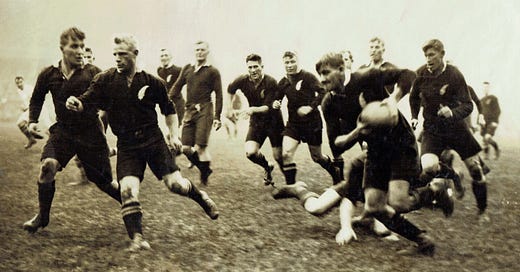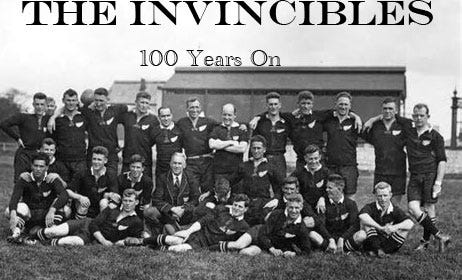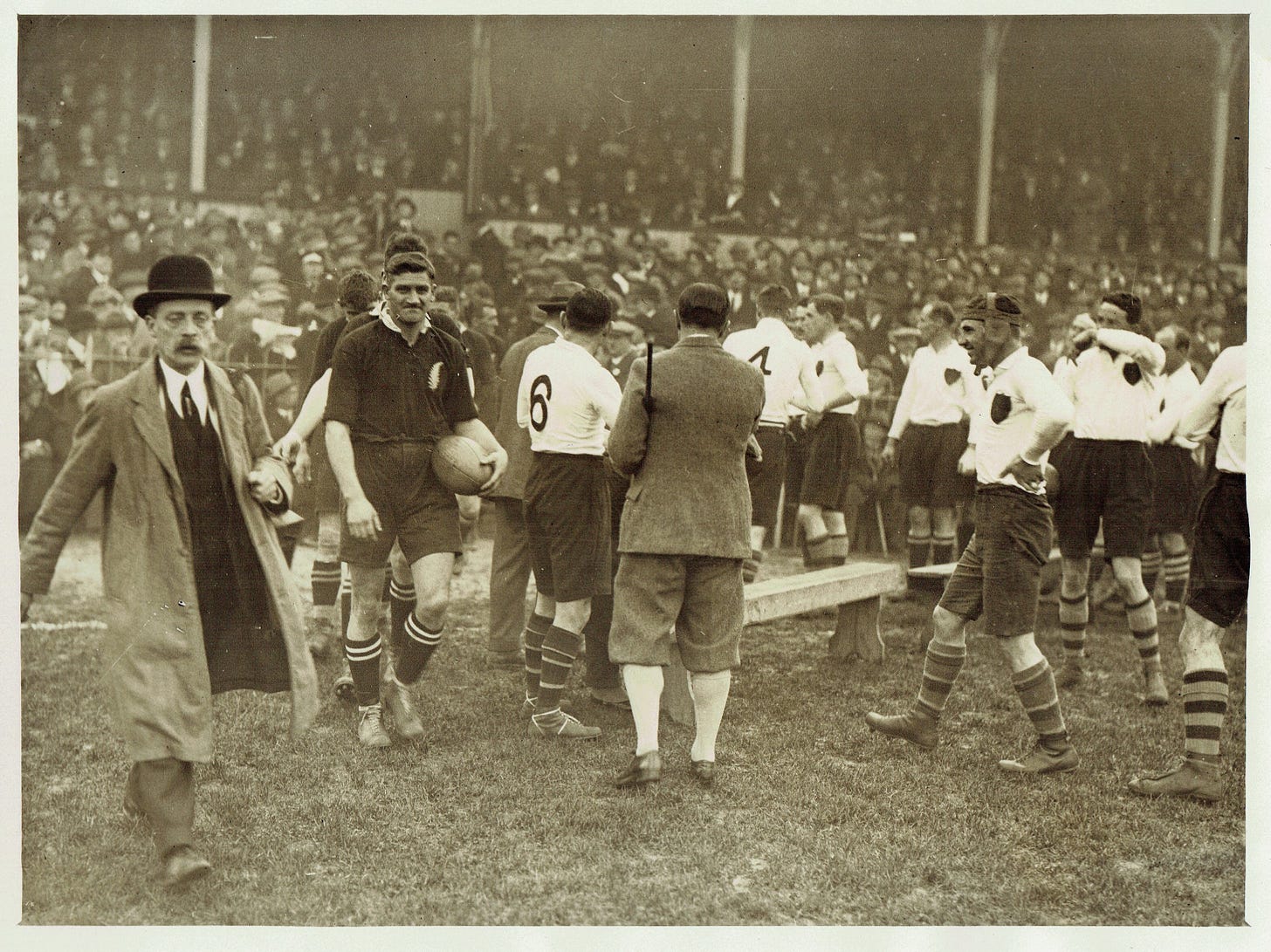A tortuous three games in six days for the 1924-25 All Blacks were eased knowing they would have 10 days of much-needed rest and recuperation before their all-important last two games in England.
In Coventry, fresh from a day's outing to Rugby School, the game against Warwickshire was played on a local soccer ground, which allowed a crowd of 20,000 to watch. Arthur Carman said the crowd was, 'given a good exhibition of how one team can play rugby with no opposition.'[1]
The All Blacks were on attack almost continuously, and the score would certainly have been more had they not taken things so lackadaisically. [Halfback Bill] Dalley and [Second five-eighths Lui] Paewai, it was obvious, were out to open their scoring account for the tour while they had the chance, and whilst the latter managed it, Dalley, after repeated attempts from scrummages, could not get over. In this game, the best play was seen when the two wings got going; both Steel and Hart running with great determination and speed. Of our forwards, M. Brownlie was easily the best and made many great openings. He is the best forward I have seen, working hard all the time both in the tight and loose, keeps right on the ball, and every opportunity starts passing rushes.[2]
The game was notable for Ian Harvey, who played his first game since October 4. Abe Munro was also due to play, but he broke down while warming up, and his knee injury denied him any more tour play.
The All Blacks’ capacity for support play is encapsulated in this action as ‘Son’ White carries the ball (NZ Rugby Museum)
Steel had been wearing sprinting spikes while doing extended training, and it paid off when he put his speed to use in scoring the first try after 13 minutes. The game also highlighted how much first five-eighths Neil McGregor had become a central part of the side's tactical approach. It was his break that saw Gus Hart score and give the All Blacks an 8-0 lead at halftime. Dalley made a break soon after halftime, and while the crowd felt he committed a forward pass, he moved the ball to Paewai, who scored. Steel scored a second try and while Warwickshire would not lie down, they couldn't press for points. They got close to the All Blacks' line, but Steel got the ball, burst through the opposition and raced to the other end of the field before being downed by home forward N. Pugh. The forwards arrived, won the ruck and as the ball skittered free, McGregor swooped on it and scored.[3]
Steel had time to complete a hat-trick of tries before the end.
Scorers: Warwickshire 0 New Zealand 20 (Jack Steel 3, Gus Hart, Lui Paewai, Neil McGregor tries; George Nepia con). HT: 0-8. Referee, T.J. Bradburn, NZ touch judge, J.H. Parker.
Combined Services was regarded as one of the hardest teams to beat outside the Test matches. In their preparation, the Navy, Army and Air Force representatives had the benefit of four games over a month. Their side included four Test players and all the players had played against the All Blacks in their non-Test games. They knew what to expect, but it did them little favour.
Nicholls was still on the injury list, which was expected to be an added advantage for the home side playing at Twickenham.
But A.J. Harrop said in Nicholls' absence,
McGregor, however, rose to the occasion in brilliant style and proved himself as good in attack as previous matches have proved him to be sound in defence. He cut out openings, kicked with admirable discretion, and never let a man pass him. Cooke has acquired so splendid a reputation that it is no injustice to him to say that he did not reach the best form of which he was capable. Nevertheless, he played a magnificent game.
Lucas, at centre, played a splendid game, which will somewhat complicate the selection of the international team, but which was delightful to watch. He ran with great resolution and timed his passes beautifully. Svenson, on the wing, gave a great exhibition of football. He was not quite fast enough to be able to rely on orthodox wing play, and two or three times he cut into the centre of the field and beat man after man before transferring to the other backs. On one occasion, when he did this, the best try of the match, in my opinion, resulted. Practically all the inside backs handled after Svenson, and then three forwards finished the movement, Richardson scoring wide out on the opposite side of the ground, from which Svenson had received the initial pass of the movement. Mill has improved vastly as a scrum-half since the beginning of the tour, and in attack, he is a shade better than Dalley. The balance is retrieved in defence, but it is probable that Mill will play in the game against England.[4]
But the All Blacks faced a referee who gave them no advantage, penalising them 16 teams compared to four for the home side. One newspaper, Sporting Life and Sportsman claimed it was the first time a home referee had been brave enough to recognise the lineout obstruction the All Blacks employed.
It made little difference. The All Blacks scored seven tries without an answer. They were up 8-3 at halftime, and they made an outstanding start to the second half when Maurice Brownlie took the restart on the full to set off on a downfield run. Quentin Donald, Son White, and Jock Richardson all handled before the ball was let out to Cooke, who provided the space for Fred Lucas to score.
Lucas and Cooke were giving a very clever exhibition; their passing and backing-up were excellent. Cooke's pace enabled him to beat the opposition, and his tackling was of the best. The forwards were all playing together, showing splendid teamwork. Porter, who has not struck form, opened up the game and was never beaten. He was responsible for the next try, making a very strong run through the opposing backs, which Steel finished off by crossing near the corner.[5]
Remembering how the 1905-06 All Blacks were worn down by the end of their tour, there was a constant concern that something similar would happen to Porter's men. However, Harrop was convinced that concerns about player fatigue wearing the All Blacks down were unwarranted.
I made up my mind after the match that the All Blacks would beat England. The game itself showed that on a big occasion, the team could shake off any staleness resulting from the heavy strain of the tour and play as well as they have ever played.
But the chief thing which convinced me that the All Blacks had the ability and the will to beat England was an evening which I spent with several members of the team in London after the match. The men, without indulging in heroics of any kind, showed that they are absolutely determined to use up every ounce of energy to uphold the honour of New Zealand. So excellent is the spirit of the team, that it has been possible to give the members four days' leave after the Hampshire match without feeling the slightest anxiety that a single man will abuse his privileges. Experienced men have assured me that they have never had anything to do with a touring team which has had a more complete recognition of its responsibilities.[6]
Scorers: Combined Services 3 (J.W. Forrest pen) New Zealand 25 (Fred Lucas 3, Jack Steel 2, Read Master, Jock Richardson tries; Son White con; George Nepia con). HT: 3-8. Referee, F.C. Potter-Irwin, NZ touch judge, S.F. Wilson.
Portsmouth welcomed the All Blacks on the morning of the Hampshire game with a thick fog. It cleared around lunchtime, allowing the game to start, but it came in again late in the second half. Five of the Hampshire team appeared for Combined Services in the previous game. One of the Irishmen, Harry Stephenson, was playing his fourth game against the tourists, while the All Blacks made four changes with 'Son' White as captain.
However, Hampshire lost forward D Orr-Ewing to a dislocated shoulder early in the game, a fate that also forced White from the field later in the game. By the time he left, White had shown how integral he had been to the side.
'Ginger' Nicholls noted,
'Son' White, who captained the team today, played excellently, leading the forwards in fine style, and altogether made a good captain. He was well backed up by Parker and Donald, who were in fine form. Their following through brought about three of the five tries scored. Harvey played as well as his condition would allow him; he has a lot of weight to make up yet before he can be classed as fit 'A'. Irvine and M. Brownlie were good but showed signs of the strenuous tour.[7]
‘Son’ White leads the All Blacks out ahead of their game with Hampshire. (NZ Rugby Museum)
The fog rolled again in the second half. The referee asked both sides if they wanted to continue. Again, Nicholls recounted,
It was decidedly funny watching for the players to appear. The range of visibility was about twenty yards. How the referee managed I do not know. McGregor scored the last try. Picking up on the open side, he came round the blindside and passed to Svenson, who ran well and passed it back to McGregor, who scored a clever try. Nepia kicked a magnificent goal, despite the fact that the goalposts were not visible.[8]
Nicholls felt Major H.E.B. Williams was one of the best referees the All Blacks had on the tour. He made extensive use of the advantage law, and only four penalties, two each were awarded during the game, a display more in keeping with what might be expected of a New Zealand referee.
Arthur Carman said it was the best display of the tour and quoted a member of the 1905 side in attendance [probably E.E. Booth] as saying it was the first time the side played throughout a game in the manner of the 1905 side.
All who saw that game will remember for all time the good clean hooking, swift passing and straight running, together with the usual sound defence. What wonderful passing the backs showed us, and when we recall the great dashes of Cooke, the inspired form of Lucas, and all the old-time determination of Steel, we realise that it was a game of superlatives.[9]
But the strain was telling and George Nepia said signs of staleness were apparent. There was great relief when manager Stan Dean called the team together and said,
'Look here, boys, you've ten days before your next game against London Counties, which will be a pipe-opener to this last match of the tour in Britain. Away you go. I don't care where, but take care of yourselves'. We did go away in the full sense of the expression for we scattered to the four corners of the Kingdom.[10]
Scorers: Hampshire 0 New Zealand 22 (Neil McGregor 2, Quentin Donald, Bert Cooke, 'Snowy' Svenson tries; George Nepia con, pen; 'Son' White con). HT: 0-8. Referee, Major H.E.B. Williams; NZ touch judge, Jock Richardson.
NEXT ISSUE: The force that was Maurice Brownlie
[1] Arthur Carman, The Press, 23 January 1925
[2] ibid
[3] H.E. 'Ginger' Nicholls, NZ Free Lance, 4 February 1925
[4] A.J. Harrop, The Press, 21 January 1925
[5] H.E. 'Ginger' Nicholls, NZ Free Lance, 4 February 1925
[6] A.J. Harrop, The Press, 21 January 1925
[7] H.E. 'Ginger' Nicholls, NZ Free Lance, 11 February 1925
[8] ibid
[9] A.H. Carman, NZ Sportsman, 19 October 1935
[10] George Nepia, NZ Truth, 11 November 1936






I find these reworked match reports of old games played in a different era fascinating. They form a part of the rich tapestry of our social history. You may be interested in the Swansea RFC web site which carries an extensive history section including accounts of all the touring team games. The Invincibles destroyed us 39-3......but eleven years later we took our revenge.